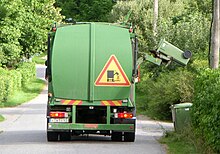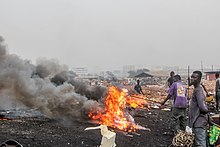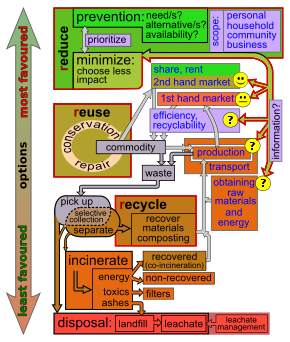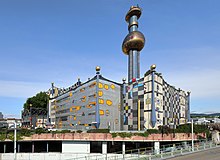
A | B | C | D | E | F | G | H | CH | I | J | K | L | M | N | O | P | Q | R | S | T | U | V | W | X | Y | Z | 0 | 1 | 2 | 3 | 4 | 5 | 6 | 7 | 8 | 9
This article has multiple issues. Please help improve it or discuss these issues on the talk page. (Learn how and when to remove these template messages)
|
| Part of a series on |
| Pollution |
|---|
 |




Waste management or waste disposal includes the processes and actions required to manage waste from its inception to its final disposal.[1] This includes the collection, transport, treatment, and disposal of waste, together with monitoring and regulation of the waste management process and waste-related laws, technologies, and economic mechanisms.
Waste can be solid, liquid, or gases and each type has different methods of disposal and management. Waste management deals with all types of waste, including industrial, biological, household, municipal, organic, biomedical, radioactive wastes. In some cases, waste can pose a threat to human health.[2] Health issues are associated with the entire process of waste management. Health issues can also arise indirectly or directly: directly through the handling of solid waste, and indirectly through the consumption of water, soil, and food.[2] Waste is produced by human activity, for example, the extraction and processing of raw materials.[3] Waste management is intended to reduce the adverse effects of waste on human health, the environment, planetary resources, and aesthetics.
The aim of waste management is to reduce the dangerous effects of such waste on the environment and human health. A big part of waste management deals with municipal solid waste, which is created by industrial, commercial, and household activity.[4]
Waste management practices are not uniform among countries (developed and developing nations); regions (urban and rural areas), and residential and industrial sectors can all take different approaches.[5]
Proper management of waste is important for building sustainable and liveable cities, but it remains a challenge for many developing countries and cities. A report found that effective waste management is relatively expensive, usually comprising 20%–50% of municipal budgets. Operating this essential municipal service requires integrated systems that are efficient, sustainable, and socially supported.[6] A large portion of waste management practices deal with municipal solid waste (MSW) which is the bulk of the waste that is created by household, industrial, and commercial activity.[7] According to the Intergovernmental Panel on Climate Change (IPCC), municipal solid waste is expected to reach approximately 3.4 Gt by 2050; however, policies and lawmaking can reduce the amount of waste produced in different areas and cities of the world.[8] Measures of waste management include measures for integrated techno-economic mechanisms[9] of a circular economy, effective disposal facilities, export and import control[10][11] and optimal sustainable design of products that are produced.
In the first systematic review of the scientific evidence around global waste, its management, and its impact on human health and life, authors concluded that about a fourth of all the municipal solid terrestrial waste is not collected and an additional fourth is mismanaged after collection, often being burned in open and uncontrolled fires – or close to one billion tons per year when combined. They also found that broad priority areas each lack a "high-quality research base", partly due to the absence of "substantial research funding", which motivated scientists often require.[12][13] Electronic waste (ewaste) includes discarded computer monitors, motherboards, mobile phones and chargers, compact discs (CDs), headphones, television sets, air conditioners and refrigerators. According to the Global E-waste Monitor 2017, India generates ~ 2 million tonnes (Mte) of e-waste annually and ranks fifth among the e-waste producing countries, after the United States, the People's Republic of China, Japan and Germany.[14]
Effective 'Waste Management' involves the practice of '7R' - 'R'efuse, 'R'educe', 'R'euse, 'R'epair, 'R'epurpose, 'R'ecycle and 'R'ecover. Amongst these '7R's, the first two ('Refuse' and 'Reduce') relate to the non-creation of waste - by refusing to buy non-essential products and by reducing consumption. The next two ('Reuse' and 'Repair') refer to increasing the usage of the existing product, with or without the substitution of certain parts of the product. 'Repurpose' and 'Recycle' involve maximum usage of the materials used in the product, and 'Recover' is the least preferred and least efficient waste management practice involving the recovery of embedded energy in the waste material. For example, burning the waste to produce heat (and electricity from heat). Certain non-biodegradable products are also dumped away as 'Disposal', and this is not a "waste-'management'" practice.[15]
Principles of waste management

Waste hierarchy
The waste hierarchy refers to the "3 Rs" Reduce, Reuse and Recycle, which classifies waste management strategies according to their desirability in terms of waste minimisation. The waste hierarchy is the bedrock of most waste minimization strategies. The aim of the waste hierarchy is to extract the maximum practical benefits from products and to generate the minimum amount of end waste; see: resource recovery.[16][17] The waste hierarchy is represented as a pyramid because the basic premise is that policies should promote measures to prevent the generation of waste. The next step or preferred action is to seek alternative uses for the waste that has been generated, i.e., by re-use. The next is recycling which includes composting. Following this step is material recovery and waste-to-energy. The final action is disposal, in landfills or through incineration without energy recovery. This last step is the final resort for waste that has not been prevented, diverted, or recovered.[18][page needed] The waste hierarchy represents the progression of a product or material through the sequential stages of the pyramid of waste management. The hierarchy represents the latter parts of the life-cycle for each product.[19]
Life-cycle of a product
The life-cycle of a product, often referred to as the product lifecycle, encompasses several key stages that begin with the design phase and proceed through manufacture, distribution, and primary use. After these initial stages, the product moves through the waste hierarchy's stages of reduce, reuse, and recycle. Each phase in this lifecycle presents unique opportunities for policy intervention, allowing stakeholders to rethink the necessity of the product, redesign it to minimize its waste potential, and extend its useful life.
During the design phase, considerations can be made to ensure that products are created with fewer resources, are more durable, and are easier to repair or recycle. This stage is critical for embedding sustainability into the product from the outset. Designers can select materials that have lower environmental impacts and create products that require less energy and resources to produce.
Manufacturing offers another crucial point for reducing waste and conserving resources. Innovations in production processes can lead to more efficient use of materials and energy, while also minimizing the generation of by-products and emissions. Adopting cleaner production techniques and improving manufacturing efficiency can significantly reduce the environmental footprint of a product.
Distribution involves the logistics of getting the product from the manufacturer to the consumer. Optimizing this stage can involve reducing packaging, choosing more sustainable transportation methods, and improving supply chain efficiencies to lower the overall environmental impact. Efficient logistics planning can also help in reducing fuel consumption and greenhouse gas emissions associated with the transport of goods.
The primary use phase of a product's lifecycle is where consumers interact with the product. Policies and practices that encourage responsible use, regular maintenance, and the proper functioning of products can extend their lifespan, thus reducing the need for frequent replacements and decreasing overall waste.
Once the product reaches the end of its primary use, it enters the waste hierarchy's stages. The first stage, reduction, involves efforts to decrease the volume and toxicity of waste generated. This can be achieved by encouraging consumers to buy less, use products more efficiently, and choose items with minimal packaging.
The reuse stage encourages finding alternative uses for products, whether through donation, resale, or repurposing. Reuse extends the life of products and delays their entry into the waste stream.
Recycling, the final preferred stage, involves processing materials to create new products, thus closing the loop in the material lifecycle. Effective recycling programs can significantly reduce the need for virgin materials and the environmental impacts associated with extracting and processing those materials.
Product life-cycle analysis (LCA) is a comprehensive method for evaluating the environmental impacts associated with all stages of a product's life. By systematically assessing these impacts, LCA helps identify opportunities to improve environmental performance and resource efficiency. Through optimizing product designs, manufacturing processes, and end-of-life management, LCA aims to maximize the use of the world's limited resources and minimize the unnecessary generation of waste.
In summary, the product lifecycle framework underscores the importance of a holistic approach to product design, use, and disposal. By considering each stage of the lifecycle and implementing policies and practices that promote sustainability, it is possible to significantly reduce the environmental impact of products and contribute to a more sustainable future.
Resource efficiency
Resource efficiency reflects the understanding that global economic growth and development can not be sustained at current production and consumption patterns. Globally, humanity extracts more resources to produce goods than the planet can replenish. Resource efficiency is the reduction of the environmental impact from the production and consumption of these goods, from final raw material extraction to the last use and disposal.
Polluter-pays principle
The polluter-pays principle mandates that the polluting party pays for the impact on the environment. With respect to waste management, this generally refers to the requirement for a waste generator to pay for appropriate disposal of the unrecoverable material.[20]
History
Throughout most of history, the amount of waste generated by humans was insignificant due to low levels of population density and exploitation of natural resources. Common waste produced during pre-modern times was mainly ashes and human biodegradable waste, and these were released back into the ground locally, with minimum environmental impact. Tools made out of wood or metal were generally reused or passed down through the generations.
However, some civilizations have been more profligate in their waste output than others. In particular, the Maya of Central America had a fixed monthly ritual, in which the people of the village would gather together and burn their rubbish in large dumps.[21]
Modern era

Following the onset of industrialisation and the sustained urban growth of large population centres in England, the buildup of waste in the cities caused a rapid deterioration in levels of sanitation and the general quality of urban life. The streets became choked with filth due to the lack of waste clearance regulations.[22] Calls for the establishment of municipal authority with waste removal powers occurred as early as 1751, when Corbyn Morris in London proposed that "... as the preservation of the health of the people is of great importance, it is proposed that the cleaning of this city, should be put under one uniform public management, and all the filth be...conveyed by the Thames to proper distance in the country".[23]
However, it was not until the mid-19th century, spurred by increasingly devastating cholera outbreaks and the emergence of a public health debate that the first legislation on the issue emerged. Highly influential in this new focus was the report The Sanitary Condition of the Labouring Population in 1842[24] of the social reformer, Edwin Chadwick, in which he argued for the importance of adequate waste removal and management facilities to improve the health and wellbeing of the city's population.
In the UK, the Nuisance Removal and Disease Prevention Act of 1846 began what was to be a steadily evolving process of the provision of regulated waste management in London.[25] The Metropolitan Board of Works was the first citywide authority that centralized sanitation regulation for the rapidly expanding city, and the Public Health Act 1875 made it compulsory for every household to deposit their weekly waste in "moveable receptacles" for disposal—the first concept for a dustbin.[26] In the Ashanti Empire by the 19th century, there existed a Public Works Department that was responsible for sanitation in Kumasi and its suburbs. They kept the streets clean daily and commanded civilians to keep their compounds clean and weeded.[27]

The dramatic increase in waste for disposal led to the creation of the first incineration plants, or, as they were then called, "destructors". In 1874, the first incinerator was built in Nottingham by Manlove, Alliott & Co. Ltd. to the design of Alfred Fryer.[23] However, these were met with opposition on account of the large amounts of ash they produced and which wafted over the neighbouring areas.[28]
Similar municipal systems of waste disposal sprung up at the turn of the 20th century in other large cities of Europe and North America. In 1895, New York City became the first U.S. city with public-sector garbage management.[26]
Early garbage removal trucks were simply open-bodied dump trucks pulled by a team of horses. They became motorized in the early part of the 20th century and the first closed-body trucks to eliminate odours with a dumping lever mechanism were introduced in the 1920s in Britain.[29] These were soon equipped with 'hopper mechanisms' where the scooper was loaded at floor level and then hoisted mechanically to deposit the waste in the truck. The Garwood Load Packer was the first truck in 1938, to incorporate a hydraulic compactor.
Waste handling and transport

Waste collection methods vary widely among different countries and regions. Domestic waste collection services are often provided by local government authorities, or by private companies for industrial and commercial waste. Some areas, especially those in less developed countries, do not have formal waste-collection systems.
Waste handling practices
Curbside collection is the most common method of disposal in most European countries, Canada, New Zealand, the United States, and many other parts of the developed world in which waste is collected at regular intervals by specialised trucks. This is often associated with curb-side waste segregation. In rural areas, waste may need to be taken to a transfer station. Waste collected is then transported to an appropriate disposal facility. In some areas, vacuum collection is used in which waste is transported from the home or commercial premises by vacuum along small bore tubes. Systems are in use in Europe and North America.
In some jurisdictions, unsegregated waste is collected at the curb-side or from waste transfer stations and then sorted into recyclables and unusable waste. Such systems are capable of sorting large volumes of solid waste, salvaging recyclables, and turning the rest into bio-gas and soil conditioners. In San Francisco, the local government established its Mandatory Recycling and Composting Ordinance in support of its goal of "Zero waste by 2020", requiring everyone in the city to keep recyclables and compostables out of the landfill. The three streams are collected with the curbside "Fantastic 3" bin system – blue for recyclables, green for compostables, and black for landfill-bound materials – provided to residents and businesses and serviced by San Francisco's sole refuse hauler, Recology. The city's "Pay-As-You-Throw" system charges customers by the volume of landfill-bound materials, which provides a financial incentive to separate recyclables and compostables from other discards. The city's Department of the Environment's Zero Waste Program has led the city to achieve 80% diversion, the highest diversion rate in North America.[30] Other businesses such as Waste Industries use a variety of colors to distinguish between trash and recycling cans. In addition, in some areas of the world the disposal of municipal solid waste can cause environmental strain due to official not having benchmarks that help measure the environmental sustainability of certain practices.[31]
Waste segregation

This is the separation of wet waste and dry waste. The purpose is to recycle dry waste easily and to use wet waste as compost. When segregating waste, the amount of waste that gets landfilled reduces considerably, resulting in lower levels of air and water pollution. Importantly, waste segregation should be based on the type of waste and the most appropriate treatment and disposal. This also makes it easier to apply different processes to the waste, like composting, recycling, and incineration. It is important to practice waste management and segregation as a community. One way to practice waste management is to ensure there is awareness. The process of waste segregation should be explained to the community.[32]
Segregated waste is also often cheaper to dispose of because it does not require as much manual sorting as mixed waste. There are a number of important reasons why waste segregation is important such as legal obligations, cost savings, and protection of human health and the environment. Institutions should make it as easy as possible for their staff to correctly segregate their waste. This can include labelling, making sure there are enough accessible bins, and clearly indicating why segregation is so important.[33] Labeling is especially important when dealing with nuclear waste due to how much harm to human health the excess products of the nuclear cycle can cause.[34]
Hazards of Waste Management
There are multiple facets of waste management that all come with hazards, both for those around the disposal site and those who work within waste management. Exposure to waste of any kind can be detrimental to the health of the individual, primary conditions that worsen with exposure to waste are asthma and tuberculosis.[35] The exposure to waste on an average individual is highly dependent on the conditions around them, those in less developed or lower income areas are more susceptible to the effects of waste product, especially though chemical waste.[36] The range of hazards due to waste is extremely large and covers every type of waste, not only chemical. There are many different guidelines to follow for disposing different types of waste.[37]

The hazards of incineration are a large risk to many variable communities, including underdeveloped countries and countries or cities with little space for landfills or alternatives. Burning waste is an easily accessible option for many people around the globe, it has even been encouraged by the World Health Organization when there is no other option.[38] Because burning waste is rarely paid attention to, its effects go unnoticed. The release of hazardous materials and CO2 when waste is burned is the largest hazard with incineration.[39]
Financial models
In most developed countries, domestic waste disposal is funded from a national or local tax which may be related to income, or property values. Commercial and industrial waste disposal is typically charged for as a commercial service, often as an integrated charge which includes disposal costs. This practice may encourage disposal contractors to opt for the cheapest disposal option such as landfill rather than the environmentally best solution such as re-use and recycling.
Financing solid waste management projects can be overwhelming for the city government, especially if the government see it as an important service they should render to the citizen. Donors and grants are a funding mechanism that is dependent on the interest of the donor organization. As much as it is a good way to develop a city's waste management infrastructure, attracting and utilizing grants is solely reliant on what the donor considers important. Therefore, it may be a challenge for a city government to dictate how the funds should be distributed among the various aspect of waste management.[40]
An example of a country that enforces a waste tax is Italy. The tax is based on two rates: fixed and variable. The fixed rate is based on the size of the house while the variable is determined by the number of people living in the house.[41]
The World Bank finances and advises on solid waste management projects using a diverse suite of products and services, including traditional loans, results-based financing, development policy financing, and technical advisory. World Bank-financed waste management projects usually address the entire lifecycle of waste right from the point of generation to collection and transportation, and finally treatment and disposal.[6]
Disposal methods
Landfill
A landfill site, also known as a tip, dump, rubbish dump, garbage dump, trash dump, or dumping ground, is a site for the disposal of waste materials. Landfill is the oldest and most common form of waste disposal, although the systematic burial of the waste with daily, intermediate and final covers only began in the 1940s. In the past, refuse was simply left in piles or thrown into pits; in archeology this is known as a midden.
Some landfill sites are used for waste management purposes, such as temporary storage, consolidation and transfer, or for various stages of processing waste material, such as sorting, treatment, or recycling. Unless they are stabilized, landfills may undergo severe shaking or soil liquefaction of the ground during an earthquake. Once full, the area over a landfill site may be reclaimed for other uses.

Incineration

Incineration is a disposal method in which solid organic wastes are subjected to combustion so as to convert them into residue and gaseous products. This method is useful for the disposal of both municipal solid waste and solid residue from wastewater treatment. This process reduces the volume of solid waste by 80 to 95 percent.[42] Incineration and other high-temperature waste treatment systems are sometimes described as "thermal treatment". Incinerators convert waste materials into heat, gas, steam, and ash.
Incineration is carried out both on a small scale by individuals and on a large scale by industry. It is used to dispose of solid, liquid, and gaseous waste. It is recognized as a practical method of disposing of certain hazardous waste materials (such as biological medical waste). Incineration is a controversial method of waste disposal, due to issues such as the emission of gaseous pollutants including substantial quantities of carbon dioxide.
Incineration is common in countries such as Japan where land is more scarce, as the facilities generally do not require as much area as landfills. Waste-to-energy (WtE) or energy-from-waste (EfW) are broad terms for facilities that burn waste in a furnace or boiler to generate heat, steam, or electricity. Combustion in an incinerator is not always perfect and there have been concerns about pollutants in gaseous emissions from incinerator stacks. Particular concern has focused on some very persistent organic compounds such as dioxins, furans, and PAHs, which may be created and which may have serious environmental consequences and some heavy metals such as mercury[43] and lead which can be volatilised in the combustion process..
Recycling

Recycling is a resource recovery practice that refers to the collection and reuse of waste materials such as empty beverage containers. This process involves breaking down and reusing materials that would otherwise be gotten rid of as trash. There are numerous benefits of recycling, and with so many new technologies making even more materials recyclable, it is possible to clean up the Earth.[44] Recycling not only benefits the environment but also positively affects the economy. The materials from which the items are made can be made into new products.[45] Materials for recycling may be collected separately from general waste using dedicated bins and collection vehicles, a procedure called kerbside collection. In some communities, the owner of the waste is required to separate the materials into different bins (e.g. for paper, plastics, metals) prior to its collection. In other communities, all recyclable materials are placed in a single bin for collection, and the sorting is handled later at a central facility. The latter method is known as "single-stream recycling".[46][47]

The most common consumer products recycled include aluminium such as beverage cans, copper such as wire, steel from food and aerosol cans, old steel furnishings or equipment, rubber tyres, polyethylene and PET bottles, glass bottles and jars, paperboard cartons, newspapers, magazines and light paper, and corrugated fiberboard boxes.
PVC, LDPE, PP, and PS (see resin identification code) are also recyclable. These items are usually composed of a single type of material, making them relatively easy to recycle into new products. The recycling of complex products (such as computers and electronic equipment) is more difficult, due to the additional dismantling and separation required.
The type of material accepted for recycling varies by city and country. Each city and country has different recycling programs in place that can handle the various types of recyclable materials. However, certain variation in acceptance is reflected in the resale value of the material once it is reprocessed. Some of the types of recycling include waste paper and cardboard, plastic recycling, metal recycling, electronic devices, wood recycling, glass recycling, cloth and textile and so many more.[48] In July 2017, the Chinese government announced an import ban of 24 categories of recyclables and solid waste, including plastic, textiles and mixed paper, placing tremendous impact on developed countries globally, which exported directly or indirectly to China.[49]
Re-use
Biological reprocessing
Zdroj:https://en.wikipedia.org?pojem=Waste_avoidanceText je dostupný za podmienok Creative Commons Attribution/Share-Alike License 3.0 Unported; prípadne za ďalších podmienok. Podrobnejšie informácie nájdete na stránke Podmienky použitia.
Antropológia
Aplikované vedy
Bibliometria
Dejiny vedy
Encyklopédie
Filozofia vedy
Forenzné vedy
Humanitné vedy
Knižničná veda
Kryogenika
Kryptológia
Kulturológia
Literárna veda
Medzidisciplinárne oblasti
Metódy kvantitatívnej analýzy
Metavedy
Metodika
Text je dostupný za podmienok Creative
Commons Attribution/Share-Alike License 3.0 Unported; prípadne za ďalších
podmienok.
Podrobnejšie informácie nájdete na stránke Podmienky
použitia.
www.astronomia.sk | www.biologia.sk | www.botanika.sk | www.dejiny.sk | www.economy.sk | www.elektrotechnika.sk | www.estetika.sk | www.farmakologia.sk | www.filozofia.sk | Fyzika | www.futurologia.sk | www.genetika.sk | www.chemia.sk | www.lingvistika.sk | www.politologia.sk | www.psychologia.sk | www.sexuologia.sk | www.sociologia.sk | www.veda.sk I www.zoologia.sk
